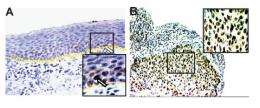New diagnostic advance seen for head, throat cancer

Pharmacy researchers at Oregon State University today announced the discovery of a genetic regulator that is expressed at higher levels in the most aggressive types of head and neck cancers, in work that may help to identify them earlier or even offer a new therapy at some point in the future.
This "transcriptional regulator" is called CTIP2, and in recent research has been demonstrated to be a master regulator that has important roles in many biological functions, ranging from the proper development of enamel on teeth to skin formation and the possible treatment of eczema or psoriasis.
In the newest study, published today in PLoS ONE, a professional journal, scientists found for the first time that levels of CTIP2 were more than five times higher in the "poorly differentiated" tumor cells that caused the most deadly types of squamous cell carcinomas in the larynx, throat, tongue and other parts of the head. There was a high correlation between greater CTIP2 expression and the aggressive nature of the cancer.
Head and neck squamous cell cancers are the sixth most common cancers in the world, the researchers said in their study, and a significant cause of mortality. In 2008, cancers of the oral cavity and pharynx alone accounted for 35,310 new cases in the United States and 7,590 deaths. They have been linked to such things as tobacco use and alcohol consumption.
"Serious head and throat cancer is pretty common, and mortality rates from it haven't improved much in 20 years, despite new types of treatments," said Gitali Indra, an assistant professor in the OSU College of Pharmacy. "With these new findings, we believe it should be possible to create an early screening and diagnostic tool to spot these cancers earlier, tell physicians which ones need the most aggressive treatments and which are most apt to recur."
It's also possible the work may lead to new therapeutic approaches, researchers say.
"It's not completely clear yet whether the higher levels of CTIP2 expression are a consequence of cancer, or part of the cause," said Arup Indra, also an OSU assistant professor of pharmacy. "However, we strongly suspect that it's causally related. If that's true, then therapies that could block production of CTIP2 may provide a new therapeutic approach to this type of cancer."
That this genetic regulator could be involved in both skin development and these types of cancer makes some sense, the scientists said - both originate from epithelial cells.
It's also possible, the study found, that CTIP2 works to help regulate the growth of what is believed to be a cancer "stem" or "progenitor" cell, which has a greater potential to generate tumors through the stem cell processes of self-renewal and differentiation into multiple cell types. Therefore, targeting cancer stem cells holds promise for improvement of survival and quality of life of cancer patients.
More information: www.pubmedcentral.nih.gov/arti … r.fcgi?artid=2671404
Source: Oregon State University (news : web)














